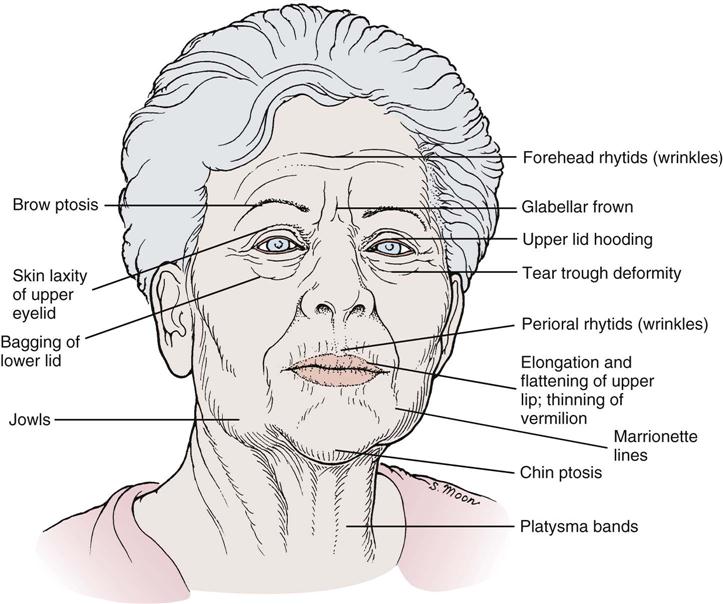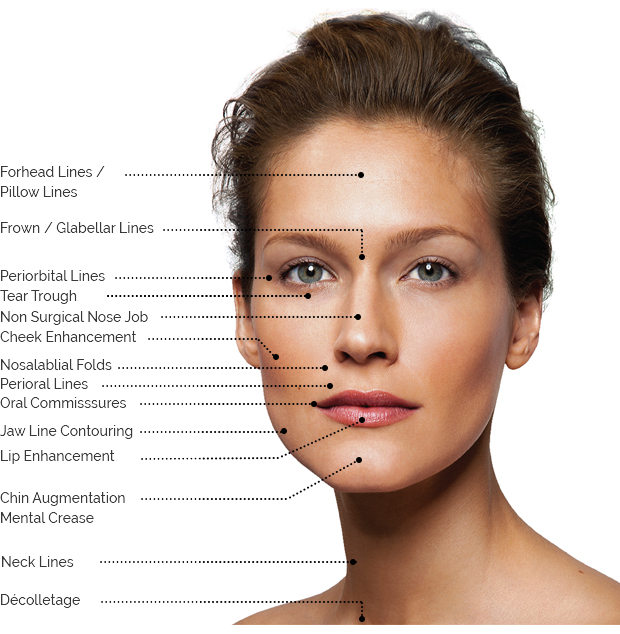Let me “Fill You In” on Dermal Fillers!
Cosmetic fillers have revolutionized the modern cosmetic surgery practice. And despite the ever increasing cultural acceptance to cosmetic enhancements and abundance of industry advertising and branding… still, many patients are confused about fillers and what they can and cannot do. As we age not only does gravity and sun damage affect the quality of our skin, but we lose volume in key areas of the face. Much like a grape becomes a raisin, volume loss significantly contributes to wrinkle formation.

Facial aging areas
Let me take a moment to clear the air and “fill you in” on the most common fillers used in my practice here at McLain Surgical Arts…
1. Hyaluronic Acid (HA) Fillers:
The most commonly HA fillers are Belotero, Juvederm, Restylane and Perlane. These types of fillers have been used in the US since 2004 and have a proven safety and performance record. Hyaluronic Acid (HA) is a normally occurring substance in the human body, primarily found in skin, joints and neural tissues. Interestingly, when skin is exposed to excessive UVB rays from the sun over time, the skin loses hyaluronic acid and begins to lose volume and vibrance. This results in premature aging. Fortunately, HA can be produced in a laboratory which nearly eliminates the potential for severe allergic reaction that was common to older collagen based fillers. Although very similar each of the types of HA fillers have specific differences based primarily on molecule size and/or the amount of crosslinking between the molecules. I personally prefer Restylane in the tear trough areas due to its ease of molding, while I prefer Juvederm in the lips because it seems to last longer.
2. Calcium Hydroxyapatite Fillers:
In 2006, the FDA approved calcium hydroxyapatite for cosmetic injection. This cosmetic filler is made of the minerals that give bone its strength and texture. These minerals are ground into tiny particles and suspended in an aquesous solution, which is injected under the skin. In the trial that led to its approval, calcium hydroxyapatite worked significantly better and lasted longer than collagen injections to reduce severe wrinkles. This filler is white and is best used at deeper levels of facial atrophy. Radiesse is my preferred filler for lower facial and cheek large volume replacement. It has perhaps the most natural result of any of the dermal fillers and has the added benefit of stimulating your skin to form its own collagen. It is not useful for lips and tear trough areas due to the need to place at very superficial levels in these areas.

Most popular facial dermal filler locations
3. Autologous Fat:
Fat grafting to fill soft tissue deficits has been around since at least the late 19th century and has gained increasing popularity in the past 20 years for facial and body volume restoration. The primary advantage of fat is that it is autologous and there is zero risk of transmittable disease or allergic reaction. It is considered semi-permanent because only a portion of the total fat grafted survives permanently, but with improvements in harvesting and application techniques one can expect about 50-60% of the transplanted fat to remain. In addition to volume restoration of the face, fat is very popular in treating body contour defects; the buttocks for example, otherwise known as a Brazilian buttock lift.
Hopefully this gives you a bit of information on the most popular fillers used here at McLain Surgical Arts. There are obviously other options, but these three forms have become the worhorses in reversing age related atrophy and wrinkles in my practice.
For more information on dermal fillers in Huntsville, Al, please visit us online or call 256.429.3411 for a complimentary consultation.

